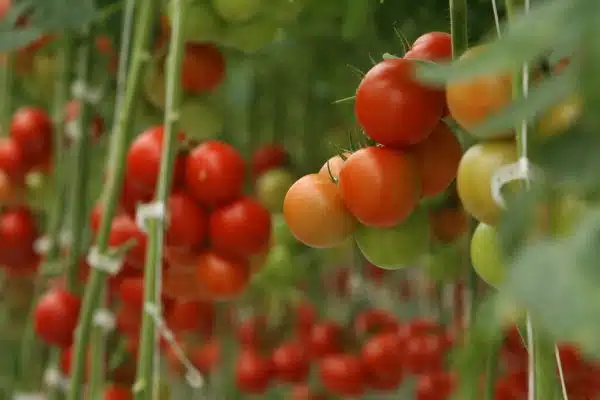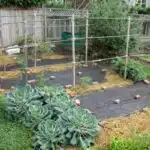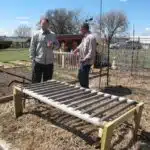Tomatoes are beloved by many gardeners, but they can be finicky plants that require careful attention to grow properly. One technique that can significantly improve the growth and health of tomato plants is planting them deep in the soil. This strategy allows the plant to develop a stronger root system, which supports better nutrient uptake and more robust growth overall.
As a seasoned expert in tomato gardening, I have seen firsthand how planting tomatoes deep can make all the difference in their growth and yield. In this article, I will explain the science behind this technique and provide practical tips for implementing it successfully in your own garden. Whether you are an experienced gardener or just starting out, understanding how to plant tomatoes deep can help you produce healthier, more productive plants that will delight your taste buds with their delicious fruit.
Understanding The Benefits Of Planting Tomatoes Deep
As a tomato gardening expert, I can confidently say that planting tomatoes deep is one of the most beneficial techniques for improving the growth and yield of your tomato plants. Deep planting ensures that the root system of your tomato plant is well-established and healthy, leading to stronger stems and more abundant fruits. In contrast, shallow planting can stunt the growth of your plant and reduce its ability to absorb nutrients from the soil.
One of the main benefits of deep planting is improved root growth. When you plant your tomato seedlings deep, you encourage the development of a strong taproot, which will anchor your plant in the soil and help it access water and nutrients more easily. Additionally, deep planting allows lateral roots to form along the stem, creating a larger surface area for nutrient absorption. This results in a healthier and more vigorous tomato plant, with better resistance to disease and environmental stress.
To achieve optimal results when planting tomatoes deep, there are several techniques you should keep in mind. First, choose seedlings that are at least six inches tall with a well-developed root system. Next, dig a hole that is deep enough to bury two-thirds of the seedling’s stem while still leaving a few leaves above ground. Finally, add compost or other organic matter to the bottom of the hole to provide additional nutrients for your tomato plant as it grows.
By now it should be clear that deep planting provides numerous benefits over shallow planting when it comes to growing healthy tomato plants. But before we dive into how this technique works on a root system level, let’s first discuss some basic principles about how these roots function within their environment.
How The Root System Of Tomato Plants Works
Understanding the benefits of planting tomatoes deep is crucial for any gardener who wants to achieve better and stronger growth in their tomato plants. By planting tomatoes deep, you can provide a more stable foundation for your plants, allowing them to grow taller and stronger. Additionally, deeper planting can help your plants develop a more extensive root system that will better support their growth.
When it comes to understanding how the root system of tomato plants works, there are a few key things to keep in mind. First, it’s important to understand that roots play a crucial role in nutrient uptake. As your tomato plants grow, their roots will spread out into the soil and absorb nutrients from the surrounding area. By planting your tomatoes deep, you can help ensure that their roots have access to these vital nutrients.
Another important factor to consider is root growth. When you plant your tomatoes deep, you encourage the development of strong and healthy roots that will support the overall growth of your plant. This is because deeper planting allows for more room for root expansion, which means that your tomato plants will be better equipped to take on environmental stresses like drought or extreme temperatures.
As you continue on your journey towards successful tomato gardening, choosing the right varieties for deep planting will be an essential step. There are many different types of tomato plants out there, each with its own unique characteristics and growth patterns. When selecting varieties for deep planting, look for those that are known for developing strong and extensive root systems. By doing so, you’ll set yourself up for success when it comes time to plant and care for your tomatoes throughout the season.
Choosing The Right Tomato Varieties For Deep Planting
When selecting tomato varieties for deep planting, it is important to consider the best options that will thrive in your specific climate and soil conditions. Some of the best varieties for deep planting include ‘Celebrity’, ‘Early Girl’, and ‘Big Beef’. These types have a strong root system that allows them to grow deeper into the soil, providing better support for their stems and fruit.
Aside from choosing the right variety, understanding the proper planting depth is also crucial. The ideal depth for planting tomatoes is at least 6-8 inches deep, with the lower leaves removed and buried underground. This ensures that the plant has enough room to establish a strong root system, leading to better nutrient absorption and overall growth.
It’s also important to consider sunlight requirements and spacing when selecting tomato varieties for deep planting. Typically, tomatoes require at least six hours of direct sunlight per day. Make sure to space each plant at least 2-3 feet apart in order to allow adequate air circulation and prevent overcrowding which can lead to disease development.
As we now understand how important it is to choose the right tomato variety and planting depth, let’s move on to preparing your garden bed for successful deep planting.
Preparing Your Garden Bed For Deep Planting
To properly plant tomatoes deep, you must first prepare your garden bed. Start by clearing any debris or weeds from the area. Next, evaluate the soil quality and determine if it needs amending with organic matter such as compost or aged manure. Raised bed gardening is an excellent option for deep planting as it allows for better drainage and aeration of the soil.
Once your garden bed is ready, it’s time to consider companion planting. Certain plants, like basil and marigolds, can help repel pests and attract beneficial insects to your tomato plants. Additionally, planting herbs and vegetables alongside your tomatoes can improve soil health and overall yield.
Before planting your tomatoes deep in the ground, create a 4-item numeric list of steps to follow:
- Dig a hole twice as deep as the root ball of your tomato plant.
- Gently remove the plant from its container and loosen any tangled roots.
- Place the plant in the hole up to its top leaves.
- Backfill with soil and gently tamp down around the base of the plant.
Selecting the best soil for tomato plants is crucial to their success in deep planting. In the next section, we will discuss what characteristics make up ideal tomato growing soil and how to properly amend it for optimal growth. Remember that proper preparation of your garden bed and careful consideration of companion planting will set you on a path towards successful tomato cultivation.
Selecting The Best Soil For Tomato Plants
To ensure the best growth and yield for your tomato plants, selecting the appropriate soil is crucial. Optimal pH levels within the soil are important for proper nutrient uptake by the plant roots. The ideal pH level for tomatoes is between 6.0 and 6.8, which allows for better absorption of nutrients such as nitrogen, phosphorus, and potassium. Soil acidity can be adjusted by adding lime to increase the pH or sulfur to decrease it.
In addition to optimal pH levels, nutrient-rich soil is key for healthy tomato plants. The use of organic matter such as compost or aged manure can provide necessary nutrients and improve soil structure. These materials also retain moisture in the soil, which helps prevent drought stress on the plants during hot summer months.
To help determine if your chosen soil has the necessary components to support tomato growth, a simple test can be done using a DIY soil testing kit or sending a sample to a professional laboratory. The results will show if any amendments are needed before planting.
Next up: tips for transplanting tomatoes deep into nutrient-rich soil!
Tips For Transplanting Tomatoes Deep
After selecting the best soil for tomato plants, it’s time to transplant them. Transplanting is a crucial process in tomato plant growth, and it should be done right to prevent transplant shock. Transplant shock occurs when plants experience stress after being moved from one location to another. The key to preventing transplant shock is to handle the plants with care and provide proper watering and drainage.
One of the critical factors in transplanting tomatoes is timing. It’s essential to choose the right time for transplanting tomatoes for better growth. The ideal time for transplanting tomatoes is when they have developed strong roots that can support their growth. It’s advisable to wait until after the last frost date in your area before transplanting them outdoors.
When transplanting tomatoes, it’s essential to dig deep holes that are at least twice as big as their root balls. This will give enough space for the roots to spread out and grow stronger. Place each plant into the hole and backfill it with soil, making sure not to cover the stem too much. Water thoroughly after planting, ensuring that water reaches all around each plant. Following these tips will ensure that your tomatoes grow strong and healthy without experiencing any transplant shock.
Providing proper watering and drainage is vital for successful tomato plant growth. When watering, ensure that you do so at ground level rather than on top of the leaves or stem, which can cause diseases such as blight or powdery mildew. Proper drainage prevents waterlogging, which can lead to root rot or other fungal diseases. By following these guidelines, you’ll be able to enjoy a bountiful harvest of delicious homegrown tomatoes in no time!
Providing Proper Watering And Drainage
Proper watering and drainage are crucial for the success of your tomato plants. When it comes to watering, consistency is key. Water your plants deeply once a week instead of giving them light sprinkles every day. This will encourage deeper root growth and make them more resilient during dry spells. Be sure to water the soil directly rather than getting water on the leaves, which can lead to fungal diseases.
One way to conserve water and make use of natural resources is through rainwater harvesting. Collecting rainwater in barrels or other containers allows you to store water for when you need it most. You can use this water to supplement your irrigation schedule during dry periods or droughts. Additionally, mulching techniques can help retain moisture in the soil by reducing evaporation and keeping roots cool during hot weather.
Mulching also helps with drainage as it prevents soil from becoming too compacted and improves aeration. Organic mulches such as straw, leaves, or grass clippings break down over time and add nutrients back into the soil. Inorganic materials like plastic sheeting or gravel can also be used but must be removed periodically to avoid buildup of harmful chemicals or salts.
Transition: Now that you have learned about proper watering techniques and using natural resources effectively, let’s move on to how fertilizing your tomato plants can further enhance their growth potential.
Fertilizing Your Tomato Plants For Maximum Growth
Proper watering and drainage are crucial components in ensuring the healthy growth of your tomato plants. Like a well-oiled machine, your plants require the right amount of water to function optimally. Water your plants deeply, but not too frequently, so that their roots can penetrate deep into the soil. This will yield stronger and more resilient plants that can withstand harsh weather conditions.
In addition to proper watering and drainage, fertilizing your tomato plants is also essential for maximum growth. Organic fertilizer options are highly recommended as they contain natural ingredients that promote healthy soil composition. Companion planting is another effective method to enhance the growth of your tomato plants. Planting certain herbs or flowers alongside your tomato plants has been known to deter pests and increase pollination.
When it comes to selecting an organic fertilizer for your tomato plants, there are several options available on the market. These include compost, bone meal, fish emulsion, and seaweed extract. Each option offers a different set of benefits depending on what you hope to achieve with your crop. Incorporating companion planting into your gardening strategy can also provide significant benefits for both you and your plant’s health.
Managing pest and disease issues is critical in maintaining the health of your tomato plant crop. Insects such as aphids, whiteflies, and hornworms can wreak havoc on your garden if left unchecked. Diseases such as blight and blossom end rot can also cause irreversible damage if not caught early enough. In our next section, we will discuss effective methods for managing these issues so that you can enjoy a bountiful harvest come harvest time!
Managing Pest And Disease Issues
Integrated pest management is important in keeping tomato plants healthy and productive. As a plant tomato gardening expert, I recommend using a combination of strategies to control pests and diseases in your garden. This approach involves utilizing cultural, mechanical, biological, and chemical controls to minimize damage and maintain a healthy garden ecosystem.
Cultural controls include practices such as crop rotation, planting resistant varieties, and proper sanitation to reduce the risk of pest and disease buildup. Mechanical controls involve physically removing pests or using barriers such as row covers or netting to exclude them from your garden. Biological controls utilize natural predators or parasites of pests to manage their populations. Chemical controls should only be used as a last resort, and organic pest control options are preferred since they are safer for the environment and human health.
Effective pest management requires vigilance and attention to detail throughout the growing season. Regular monitoring for signs of infestation or disease can help you catch issues early before they become widespread. By implementing an integrated pest management plan that incorporates various strategies, you can keep your tomato plants strong, healthy, and productive throughout the growing season.
To continue caring for your tomato plants, it is essential to learn about pruning and supporting techniques. These practices play a vital role in maintaining plant health by improving air circulation, reducing disease pressure, increasing sun exposure, and supporting fruit production. Keep reading to learn more about how to prune and support your tomato plants for optimal growth!
Pruning And Supporting Tomato Plants
- Pruning tomatoes is an important step in encouraging the production of healthy, fruitful plants by redirecting the plant’s energy into producing more fruits.
- Staking tomatoes can help to support the plant and keep it from becoming too top heavy and breaking under its own weight.
- Trellising tomatoes is an effective way to save space in the garden, while still providing the necessary support for tomato plants to grow and produce fruit.
- Pruning should be done throughout the season, removing any damaged or diseased branches and stems.
- Staking should be done early in the season to avoid damaging the tomato plant’s roots.
- Trellising can be done with stakes, cages, strings, or posts to provide the plant with the necessary support.
Pruning
As a tomato gardening expert, I cannot stress enough the importance of pruning and supporting tomato plants. Pruning techniques involve removing the side shoots or suckers that grow between the stem and branches of the plant. This allows for better air circulation and sunlight penetration, resulting in healthier growth and higher yields.
Training methods also play a crucial role in supporting tomato plants. One effective technique is to use stakes or cages to keep the plant upright as it grows taller. This prevents the plant from bending or breaking under the weight of its fruit. Additionally, regularly tying up branches to supports will help prevent them from drooping and touching the ground where they can become diseased.
When it comes to pruning, it’s important to know when and how much to prune. It’s recommended to start pruning once the plant reaches about 12-18 inches tall and then continue throughout its growth cycle. However, be careful not to over-prune as this can stunt growth and reduce yield. With proper pruning techniques and training methods, your tomato plants will be stronger, healthier, and produce more delicious fruit for you to enjoy all season long.
Staking
As a tomato gardening expert, I have seen how staking can benefit tomato plants in many ways. One of the primary advantages of staking is that it helps to keep the plant upright and prevents it from bending or breaking under the weight of its fruit. This ensures that the plant remains healthy and produces a higher yield of delicious tomatoes. Additionally, staking also improves air circulation around the plant, reducing the risk of disease.
There are different staking methods that one can use to support tomato plants. One common method is using stakes made from bamboo or metal rods to support individual stems. These stakes can be driven into the ground near each stem and tied with twine or soft cloth to hold them in place. Another approach is using cages made from wire mesh or plastic to surround each plant, providing support for multiple stems at once.
In conclusion, staking is an essential aspect of supporting tomato plants alongside pruning techniques. The benefits of staking include preventing damage and increasing yields while also promoting better air circulation and reducing disease risks. With different staking methods available to choose from, gardeners can select the one that suits their particular needs and preferences best.
Trellising
As a tomato gardening expert, I have seen the benefits of pruning and staking in promoting healthy tomato plants. However, another important aspect of supporting tomato plants is trellising. Trellising involves using a trellis design to support the plant vertically, allowing it to grow upwards instead of sprawling along the ground.
Trellising offers several advantages for tomato plants. Firstly, it saves space in the garden, making it ideal for small gardens or those with limited space. Secondly, vertical gardening allows for better air circulation around the plant, reducing the risk of disease. Finally, trellising also makes harvesting easier as tomatoes are more accessible and less likely to be damaged.
There are different types of trellis designs that gardeners can use when supporting their tomato plants. Common designs include string trellises, ladder trellises and A-frame trellises. Each design has its advantages depending on factors such as available space and personal preferences. Overall, incorporating trellising techniques into your tomato gardening strategy can help increase yield while also creating an attractive garden display.
Harvesting And Storing Your Tomato Crop
Congratulations on a successful tomato harvest! Now that you’ve spent time nurturing your plants, it’s time to enjoy the fruits of your labor. However, if you’re not planning on eating all of your tomatoes right away, it’s important to store them properly to ensure they stay fresh for as long as possible. With proper storage techniques, you can preserve your tomato harvest well into the winter months.
One great way to store tomatoes is by canning them. Canning is a preservation method that involves heating food in jars to kill off any bacteria or microorganisms that could cause spoilage. If done correctly, canned tomatoes can last for up to 18 months! Another option is freezing your tomatoes. This method is great for those who have an abundance of tomatoes but don’t want to spend hours canning them. Simply remove the stem and core, blanch the tomatoes in boiling water for 30 seconds, then transfer them to a freezer-safe container or bag.
If you’re short on space or live in an area with limited yard space, consider container gardening tomatoes. This method allows you to plant and grow tomatoes in pots or containers. Not only does this save space, but it also allows you to move your plants around for optimal sunlight exposure. Additionally, if you plan on planting other types of fruits or vegetables alongside your tomato plants, consider companion plants for tomatoes such as basil, oregano, and marigolds. These plants release natural compounds that help repel pests and attract beneficial insects to your garden.
Now that you’ve harvested and stored your tomato crop successfully let’s troubleshoot common problems with deep-planted tomatoes so that next season’s harvest will be even better!
Troubleshooting Common Problems With Deep-Planted Tomatoes
One of the most common problems that gardeners face when planting tomatoes deep is root rot. This occurs when the soil around the roots remains wet for an extended period, leading to the growth of fungi and bacteria that can destroy the roots. To prevent root rot, it is crucial to ensure proper drainage by adding organic matter such as compost to the soil before planting. Additionally, avoid watering your plants excessively, especially during periods of heavy rainfall.
Another challenge with deep-planted tomatoes is maximizing nutrient uptake. When planted deeply, tomato plants require more nutrients to reach their full potential than they would if planted at a shallower depth. To ensure maximum nutrient uptake, add a slow-release fertilizer to the soil during planting or later in the growing season. Regularly testing your soil pH levels and adjusting them accordingly can also help maximize nutrient uptake.
Overall, deep-planted tomatoes can be incredibly rewarding if done correctly. Preventing root rot and maximizing nutrient uptake are two critical steps for success. With some careful planning and attention to detail, you’ll have healthy tomato plants that produce high yields all season long. In our next section, we’ll discuss the tools and supplies you’ll need for successful deep planting.
Tools And Supplies You’ll Need For Successful Deep Planting
Tomato cages are an essential tool when deep planting tomatoes as they provide structure and support to the plants while they are growing. A shovel or trowel is necessary to dig the hole for the tomato plants, and it is beneficial to add compost and mulch to the soil to provide beneficial nutrients. Fertilizer can be added to the soil to increase the nutrient content, and a hoe, stakes, twine, trellis, pruning shears, and gloves can be used to help keep the plants upright. Finally, a garden hose, pH tester, and watering can can be used to ensure proper watering for the tomato plants.
Tomato Cages
As a gardening expert, I highly recommend using tomato cages to support your deep planted tomatoes. Tomato cages provide the necessary structure for the plant’s growth and help prevent branches from breaking under the weight of the fruit. There are several tomato cage alternatives available in the market, but nothing beats a sturdy and reliable tomato cage.
If you’re looking for DIY tomato trellis ideas, there are plenty of options to choose from. One popular option is the Florida weave method, which involves using stakes and twine to create a woven support system for your plants. Another option is the stake-and-string trellis, where you attach strings to stakes placed on either side of each plant and tie them up as they grow taller.
While it may be tempting to skip using tomato cages or trellises altogether, especially if you have limited space or budget constraints, doing so can lead to weaker plants and smaller yields. By investing in a good set of tomato cages or creating your own DIY trellis system, you’ll ensure that your deep planted tomatoes have all the support they need to thrive and produce abundant fruit.
Shovel
In addition to tomato cages and trellises, another essential tool for successful deep planting is a shovel. When choosing a shovel for your gardening needs, it’s important to consider the type of soil you’ll be working with and the tasks you’ll be performing. There are several types of shovels available, including digging shovels, transplanting shovels, and spading shovels. Digging shovels are ideal for breaking up hard soil and removing rocks, while transplanting shovels are designed for moving plants without damaging their roots. Spading shovels, on the other hand, are great for turning soil and creating new garden beds.
Proper technique is also crucial when using a shovel in your deep planting efforts. To avoid unnecessary strain or injury, it’s important to use your legs instead of your back when lifting heavy loads of soil or plants. Keep your feet shoulder-width apart and use the weight of your body to push the shovel into the ground instead of relying solely on arm strength. Additionally, try to avoid twisting your body while holding a loaded shovel as this can cause back pain or injury over time.
By selecting the right type of shovel for your gardening needs and using proper technique when using it, you’ll be able to make deep planting a breeze. Remember that investing in high-quality tools is worth it in the long run as they can save you time and effort while producing better results. With these tips in mind, you’ll be well on your way to growing healthy, fruitful tomato plants that will bring joy to both yourself and those around you.
Comparing Deep Planting To Other Tomato Growing Techniques
Just like how a plant’s roots anchor it to the ground, deep planting ensures that your tomatoes remain strong and sturdy. This technique allows the roots to extend deeper into the soil, thereby providing more nutrients and water to the plant. However, this is not the only way you can grow tomatoes. Comparing planting depths, there are pros and cons of shallow planting that may also be worth considering.
Firstly, shallow planting involves burying only a portion of the stem as opposed to deep planting’s method of covering most of it. While this technique may not provide as many nutrients as deep planting does, it allows for easier access to oxygen and sunlight. Additionally, since the stem will be partially above ground level, it will produce more roots along its length. This helps strengthen the overall root system and improve water uptake.
Secondly, another tomato growing technique worth discussing is container gardening. This method is ideal for those with limited space or poor soil conditions in their garden. Container-grown tomatoes require frequent watering but have better drainage compared to plants grown in soil directly. Also, since you control what goes into your container’s soil mix, you can customize your plant’s nutrition levels based on its specific needs.
In conclusion, while deep planting is an excellent technique that promotes stronger growth in tomatoes due to its nutrient-rich environment, other methods such as shallow planting or container gardening also have their advantages depending on individual circumstances. In our next section, we’ll address frequently asked questions about planting tomatoes deep and help you get started on your tomato growing journey.
Frequently Asked Questions About Planting Tomatoes Deep
Planting tomatoes deep is a technique that has been used by gardeners for years to promote stronger and healthier growth. However, there are common mistakes that can be made when implementing this technique. It is important to understand the benefits and drawbacks of planting tomatoes deep before attempting it in your own garden.
One common mistake when planting tomatoes deep is burying too much of the stem. While burying a portion of the stem can help the plant develop more roots and become sturdier, burying too much can lead to rotting and disease. It is recommended to bury only 1/3 to 2/3 of the stem, depending on the size of the plant.
The benefits of planting tomatoes deep include a stronger root system and increased drought resistance. By developing roots along the buried stem, the plant is able to absorb water and nutrients more efficiently, leading to an overall healthier plant. However, one drawback is that it may take longer for the plant to produce fruit as it takes time for the roots to develop fully.
| Pros | Cons |
|---|---|
| Stronger root system | Longer time to produce fruit |
| Increased drought resistance | Risk of over-burying leading to disease |
In conclusion, planting tomatoes deep can be a beneficial technique for promoting strong growth in your tomato plants. However, it is important to avoid common mistakes such as over-burying and understanding both its benefits and drawbacks before implementing it in your garden. With proper execution, this technique can lead to healthier and more productive tomato plants.
Conclusion
When it comes to growing tomatoes, planting them deep is a technique that can yield impressive results. By burying a portion of the stem, you encourage the plant to develop a stronger root system, leading to better growth and higher yields. Understanding how this technique works, choosing the right varieties, and preparing your garden bed are all key factors in successful deep planting.
Tomatoes are one of the most popular crops for home gardeners, and with good reason. They’re easy to grow, versatile in the kitchen, and packed with nutrients. By taking advantage of the benefits of deep planting, you can enjoy even greater success in your tomato harvest. So roll up your sleeves, grab your gardening tools, and get ready to plant those tomatoes deep!
Image Credits
- “Greenhouse tomatoes at recycling plant in Ankara” by World Bank Photo Collection (featured)





























